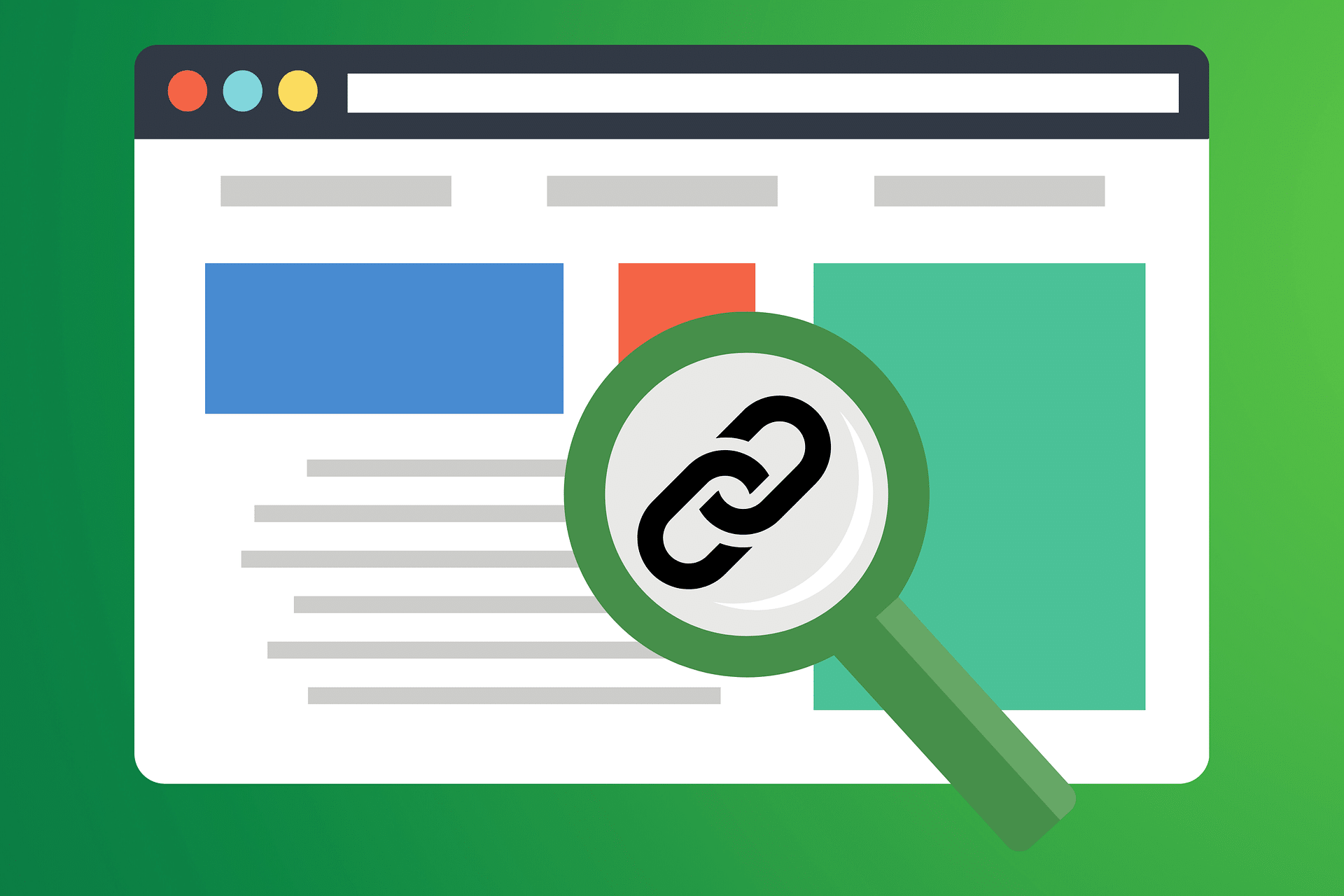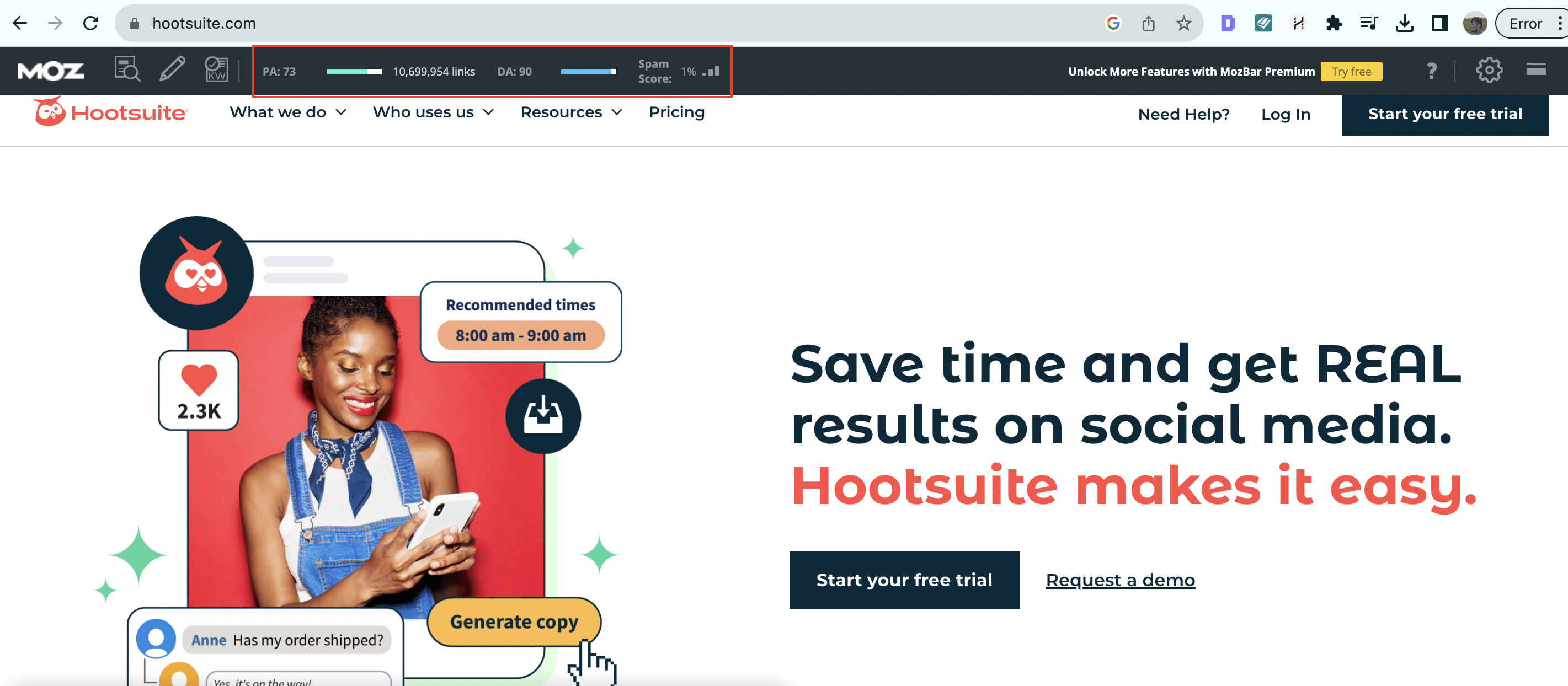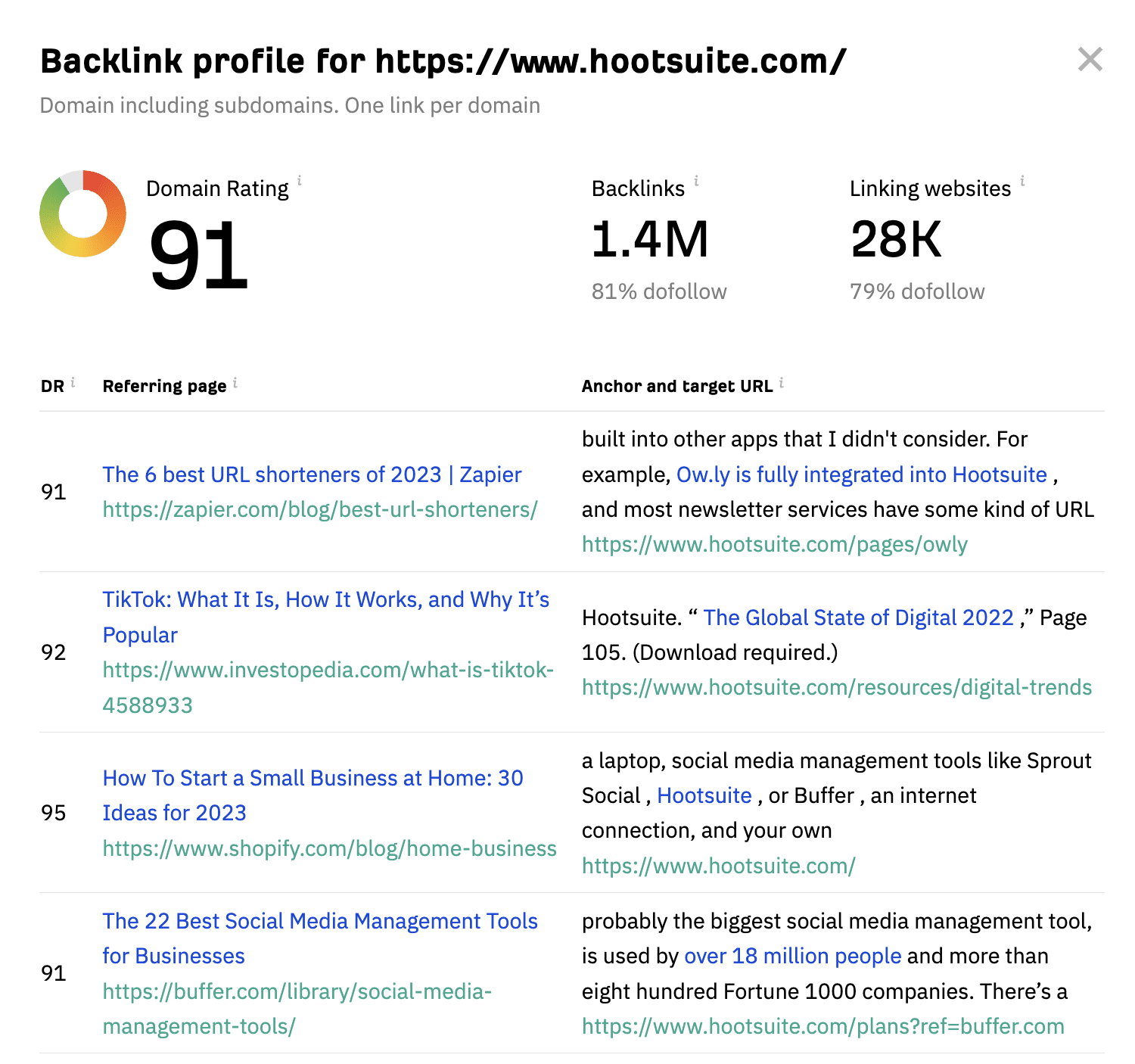One of the ways to measure the quality of a backlink is by looking at its domain authority (DA). DA is a score developed by Moz that indicates how likely a website is to rank well in search engine results. DA ranges from 1 to 100, with higher scores indicating higher authority.
High domain authority backlinks are backlinks from websites that have a high DA score, usually above 50. These backlinks can help your website rank higher for competitive keywords, drive more organic traffic, and increase your brand awareness and reputation.
In this guide, we will explain what are high domain authority backlinks, why they are important for SEO, and how to find, evaluate, and acquire them. By the end of this guide, you will have a clear understanding of how to leverage high domain authority backlinks for your SEO success.
How to Find High Domain Authority Backlinks

The first step to getting high domain authority backlinks is to find websites that have a high DA score and are relevant to your niche and audience. There are several tools and methods you can use to find these websites, such as:
- Moz Link Explorer: This is a tool by Moz that allows you to analyze any website’s backlink profile and DA score. You can use it to find websites that link to your competitors or similar websites in your niche, and filter them by DA score. You can also use it to check your own website’s DA score and see how it compares to others in your industry.
- Ahrefs Site Explorer: This is a tool by Ahrefs that allows you to analyze any website’s organic traffic, keywords, and backlink profile. You can use it to find websites that rank for keywords related to your niche, and filter them by DR score. You can also use it to check your own website’s SEO performance and see how it compares to others in your industry.
- Google search operators: These are special commands that you can use in Google search to refine your results and find specific types of websites. For example, you can use the “site:” operator to find websites that belong to a certain domain or subdomain, such as “.edu” or “.gov”. You can also use the “intitle:” operator to find websites that have a certain keyword in their title, such as “SEO” or “link building”. You can combine these operators with other keywords or phrases to find websites that are relevant to your niche and have a high DA score.
Once you have a list of potential websites that have a high DA score and are relevant to your niche, you need to narrow down your list and select the best ones for your link building campaign. Here are some tips and criteria to help you do that:
- Relevance: The most important factor to consider when choosing a website for link building is relevance. You want to get backlinks from websites that are closely related to your niche, topic, and audience. This will ensure that the backlinks are natural, valuable, and beneficial for both parties. Relevance also affects how search engines evaluate the quality of a backlink. Search engines prefer backlinks from websites that have similar content and target similar keywords as yours.
- Niche: Another factor to consider when choosing a website for link building is niche. You want to get backlinks from websites that belong to the same or related niche as yours. This will ensure that the backlinks are relevant, authoritative, and trustworthy for your niche. Niche also affects how search engines rank your website for specific keywords. Search engines prefer backlinks from websites that rank well for keywords related to your niche.
- Traffic: Another factor to consider when choosing a website for link building is traffic. You want to get backlinks from websites that have a high amount of organic traffic from search engines. This will ensure that the backlinks are visible, popular, and influential for your audience. Traffic also affects how search engines measure the popularity and authority of a website. Search engines prefer backlinks from websites that have a high amount of organic traffic from search engines.
How to Evaluate High Domain Authority Backlinks

The second step to getting high domain authority backlinks is to evaluate the quality and value of each web page’s backlink profile. A web page’s backlink profile is the collection of all the backlinks that point to that web page. Not every web page on a high DA website is equally valuable for link building. Some web pages may have more or better backlinks than others, and some web pages may be more or less relevant or authoritative than others.
One of the ways to measure the quality and value of a web page’s backlink profile is by looking at its page authority (PA). PA is another score developed by Moz that indicates how likely a web page is to rank well in search engine results. PA ranges from 1 to 100, with higher scores indicating higher authority. Higher authority pages will usually have more referring domains.
High page authority backlinks are backlinks from web pages that have a high PA score, usually above 30. These backlinks can help your website rank higher for specific keywords, drive more targeted traffic, and increase your page authority.
There are several factors or metrics that you can use to assess the quality and value of a web page’s backlink profile, such as:
- Number of links: This is the total number of backlinks that point to a web page. The more backlinks a web page has, the more popular and authoritative it is. However, not all backlinks are equal. You also need to consider the quality and relevance of the backlinks, as well as the diversity and distribution of the backlink sources.
- Anchor text: This is the clickable text that forms a backlink. The anchor text can provide clues about the content and relevance of the web page and the backlink. You want to get backlinks from web pages that have relevant and descriptive anchor texts that match your keywords and topics. You also want to avoid getting backlinks from web pages that have spammy or over-optimized anchor texts that can harm your website’s reputation and ranking.
- Link type: This is the type of link that forms a backlink. There are two main types of links: dofollow and nofollow. Dofollow links are links that pass link juice and authority to your website, while nofollow links are links that do not pass link juice and authority to your website. You want to get more dofollow links than nofollow links, as they have more impact on your website’s ranking and authority. However, you also want to have a natural and balanced mix of both types of links, as they can signal trust and diversity to search engines.
- Link location: This is the location of the link on the web page. The location of the link can affect its visibility and value for your website. You want to get backlinks from web pages that have links in prominent and relevant locations, such as the body content, the headings, or the sidebar. You want to avoid getting backlinks from web pages that have links in hidden or irrelevant locations, such as the footer, the navigation, or the ads.
There are several tools or methods that you can use to analyze a web page’s PA score and backlink profile, such as:
- MozBar: This is a browser extension by Moz that allows you to see the DA and PA scores of any website or web page you visit. You can also use it to see the number and type of links on any web page, as well as their anchor texts and locations.
- Ahrefs Backlink Checker: This is a tool by Ahrefs that allows you to see the top 100 backlinks for any website or web page you enter. You can also use it to see the number and type of links on any web page, as well as their anchor texts and locations.
Here are some examples of how to use these tools or methods to analyze a web page’s PA score and backlink profile:

This is an example of using MozBar to see the DA and PA scores of a website and a web page.

Here is an example of using Ahrefs Backlink Checker to see the top 100 backlinks for a website and a web page.
How to Acquire High Domain Authority Backlinks

The third and final step to getting high domain authority backlinks is to acquire them from the websites and web pages you have selected and evaluated. Acquiring high domain authority backlinks is not easy, as it requires time, effort, and skill. You need to build relationships with other website owners or editors, create valuable and relevant content for them, and persuade them to link to your website.
One of the ways to acquire high domain authority backlinks is by using link building strategies or techniques. Link building strategies or techniques are methods or approaches that you can use to get other websites to link to your website. There are many link building strategies or techniques that you can use, such as:
- Guest posting: This is a link building technique where you write an article for another website in your niche and include a link to your website in the author bio or the content. Guest posting can help you get high domain authority backlinks from authoritative and relevant websites, as well as exposure and traffic for your website. However, this technique also requires a lot of research, outreach, and writing skills. You need to find websites that accept guest posts, pitch them with a relevant and valuable topic, write a high-quality article that meets their guidelines, and follow up with them until your article is published.
- Link Insertions: This is a link building technique where you strategically insert links to your website into existing content on other websites. Unlike creating new content for the purpose of gaining backlinks, link insertions involve integrating your links into already published articles or pages. This method can be particularly effective because it allows you to leverage the established authority and traffic of existing content. It can also be less time-consuming than creating new guest posts or replacing broken links, as it doesn’t require you to create new content or find broken links.
- Link Exchanges: This is a link building technique where you agree with another website to link to each other’s content. Link exchanges can be a quick way to gain backlinks and can also help to foster relationships with other businesses in your niche. The process involves finding relevant websites that complement your own, and then reaching out to propose a link exchange. This could be as simple as swapping blog post links, or it could involve more complex arrangements like guest posting on each other’s sites. However, it’s important to approach link exchanges with caution. Search engines like Google have guidelines against “excessive” link exchanges and “link schemes” designed to manipulate a site’s ranking. Therefore, any link exchanges should be relevant, add value for the user, and not be used excessively.
- Skyscraper technique: This is a link building technique where you find popular content in your niche and create a better version of it, then reach out to the websites that link to the original content and ask them to link to your version instead. This technique can help you get high domain authority backlinks from websites that are interested in providing the best content and value to their audience, as well as generate more traffic and engagement for your website. However, this technique also requires a lot of creativity, analysis, and writing skills. You need to find content in your niche that has a lot of backlinks, analyze what makes it popular and successful, create a better version of it that adds more value or quality, and contact the website owners or editors that link to the original content and persuade them to link to your version instead.
There are many more link building strategies or techniques that you can use to get high domain authority backlinks for your website. The key is to be creative, proactive, and persistent in finding and pursuing opportunities for getting high-quality backlinks from authoritative and relevant websites.
Here are some tips or best practices that you can follow to optimize your outreach and content creation for link building, such as:
- Personalization: This is the practice of customizing your outreach and content to suit the preferences and needs of the website or person you are contacting. Personalization can help you build rapport, trust, and interest with your potential link partners, as well as increase your response and conversion rates. You can personalize your outreach and content by using their name, mentioning their website or content, complimenting their work, addressing their pain points or goals, etc.
- Value proposition: This is the practice of highlighting the benefits and value that your outreach and content can provide to the website or person you are contacting. Value proposition can help you persuade and motivate your potential link partners to take action and link to your website, as well as differentiate yourself from other link builders. You can create a value proposition by explaining how your link or content can help them solve a problem, achieve a goal, improve a situation, etc.
- Follow-up: This is the practice of sending a reminder or a thank you message to the website or person you have contacted after a certain period of time. Follow-up can help you maintain communication, build relationships, and increase your chances of getting a positive response or a link from your potential link partners. You can follow up by asking for feedback, providing additional information, offering assistance, expressing gratitude, etc.
These are some of the tips or best practices that you can follow to optimize your outreach and content creation for link building. However, there are many other tips or best practices that you can follow, such as:
- Research: This is the practice of doing thorough and accurate research on the websites and web pages that you want to get backlinks from, as well as on the topics and keywords that you want to rank for. Research can help you find and select the best opportunities for link building, as well as create relevant and valuable content for your potential link partners.
- Quality: This is the practice of ensuring that your outreach and content are of high quality and standard. Quality can help you establish your authority and credibility in your niche, as well as impress and satisfy your potential link partners. You can ensure quality by proofreading, editing, formatting, optimizing, etc.
- Ethics: This is the practice of following the rules and guidelines of SEO and link building. Ethics can help you avoid penalties and negative consequences from search engines and webmasters, as well as maintain your reputation and integrity in your niche. You can follow ethics by avoiding spammy or manipulative tactics, such as buying or selling links, using automated or deceptive tools, etc.
Gaining High Domain Authority Links is No Rocket Science!
In conclusion, high domain authority backlinks are backlinks from websites that have a high DA score, usually above 50. These backlinks can help your website rank higher for competitive keywords, drive more organic traffic, and increase your brand awareness and reputation.
To get high domain authority backlinks for your website, you need to find, evaluate, and acquire them from authoritative and relevant websites in your niche. You can use various tools and methods to find these websites, such as Moz Link Explorer, Ahrefs Site Explorer, Google search operators, etc. You can also use various factors or metrics to evaluate these websites, such as number of links, anchor text, link type, link location, etc.
To acquire high domain authority backlinks from these websites, you need to use various strategies or techniques to get them to link to your website. You can use various strategies or techniques to do this, such as guest posting, broken link building, resource page link building, skyscraper technique, etc. You can also use various tips or best practices to optimize your outreach and content creation for link building, such as personalization, value proposition, follow-up, etc.

